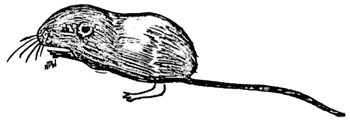Pocket Mice in Crater Lake National Park
By Dr. R. R. Huestis, Ranger-Naturalist
On July 31, 1941, to his considerable surprise, the writer took two pocket mice,(Perognathus parvus (s. sp.)) within the eastern boundary of Crater Lake National Park. A battery of ten traps had been set along the turnout for the Wheeler Creek pinnacles and ten other traps were set south of this along the east entrance highway. Each battery took a pocket mouse along with a number of Peromyscus. This edge of Wheeler Creek canyon is on the 5500 foot level.
The pocket mouse is a type particularly associated with the Sonoran Zones of the southwestern American desert. They are included in the family Heteromyidae along with the much better known kangaroo rats, also typical desert dwellers. The writer once trapped in a region of the Painted Desert in Arizona so arid that it was a considerable walk from one small creosote bush to the next, yet here a small pocket mouse was taken in many of the traps; the only mammal that touched them and apparently the only one there.
The rim of Wheeler Creek Canyon at 5500 feet is covered by a forest of lodgepole pines(Pinus contorta latifolia), the cleared spaces being occupied by waxy currant (Ribes cereum)) and Bloomer’s rabbit-brush (Chrysothamnus bloomeri). The altitude and vegetation would identify the region as lower Canadian Zone, a rather atypical habitat for pocket mice. However, the soil along Wheeler Creek rim, a powdery pumice, might be expected to be congenial.
Pocket mice are burrowing rodents with small pinnae, and compared with Peromyscus,relatively small eyes. As in the kangaroo rats the temporal bones are enlarged into thin walled bullae. These are believed to increase auditory acuity. The cheeks are supplied with fur lined pouches for storing seeds. The tail is long and furred toward the end with some relatively long stiff bristles. The hind legs are long and powerful, but pocket mice run rather than jump like the kangaroo rats. Like many burrowing mammals they are solitary and quarrelsome if kept together in captivity, one usually killing the other.
The specimens taken in Crater Lake National Park measured as follows:
| Total length | Tail length | Foot | Ear pinna |
| 149.6 mm | 82.2 | 22.5 | 8.1 |
| 155.0 mm | 85.0 | 22.5 | 8.2 |
These measurements are small for even the smaller of the two subspecies which might be expected to work into the park area: Coues’ pocket mouse, (P. p. mollipilosus), from the Upper Klamath Lake region. Both specimens were females, both had been lactating, and both were pregnant. One contained six and the other four embryos. These evidences of fertility suggest that pocket mice are in Crater Lake National Park to stay.


